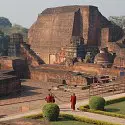About Nalanda – Bihar

Nalanda was an ancient seat of learning and a religious centre that imparted a wide range of knowledge. It existed between the fifth and twelfth centuries AD in ancient Magadha (now Bihar and parts of Bengal, Orisha in India). It was thought that the term ‘Nalanda’ came from the word nalam (lotus) or da nalanda, which meant “giver of knowledge.” The ancient Mahavihara at Nalanda was built during the reign of akrditya of the Gupta Dynasty.
Around the fifth and sixth centuries BC, both Buddha and Mahavira made trips to Nalanda. It was also the birth and nirvana place of Sariputta, one of Buddha’s most famous disciples. Many eminent Buddhist scholars studied and taught at Nalanda, including Padmasambhava, the master of Tantric Buddhism, Candrakrti, Labhadra, and Atisa, as well as Nagarjuna, who formalised the concept of Sunyata, Dharmapala, the teacher of Xuan Zang, Dharmakirti, the logician, Dinnaga, the founder of Buddhist Logic, and Jinamitra Santaraksita.
One of the first residential universities in history was Nalanda. 2,000 teachers and more than 10,000 students lived on this monastery site. Red bricks were used to construct the Mahavihara, which was regarded as a marvel of architecture. It included ten temples, eight distinct compounds, numerous classrooms and meditation halls. The library was housed in a nine-story structure where priceless copies of books were created. The subjects taught by the renowned teachers amassed every field of learning, and attracted pupils and scholars from all parts of the world-Korea, Japan, China, Tibet, Indonesia, Persia and Turkey. In 1193 A.D., an army of the Muslim Mamluk Dynasty led by Ikhtiyar ad-Din Muhammad bin Bakhtiyar Khilji pillaged and destroyed Nalanda.
The ancient Nalanda Mahavihara’s ruins currently cover 14 hectares, the most of which has not been fully excavated. Numerous tourists from India and outside visit Nalanda, Rajgir, and Bodhgaya each year due to its historical significance.
